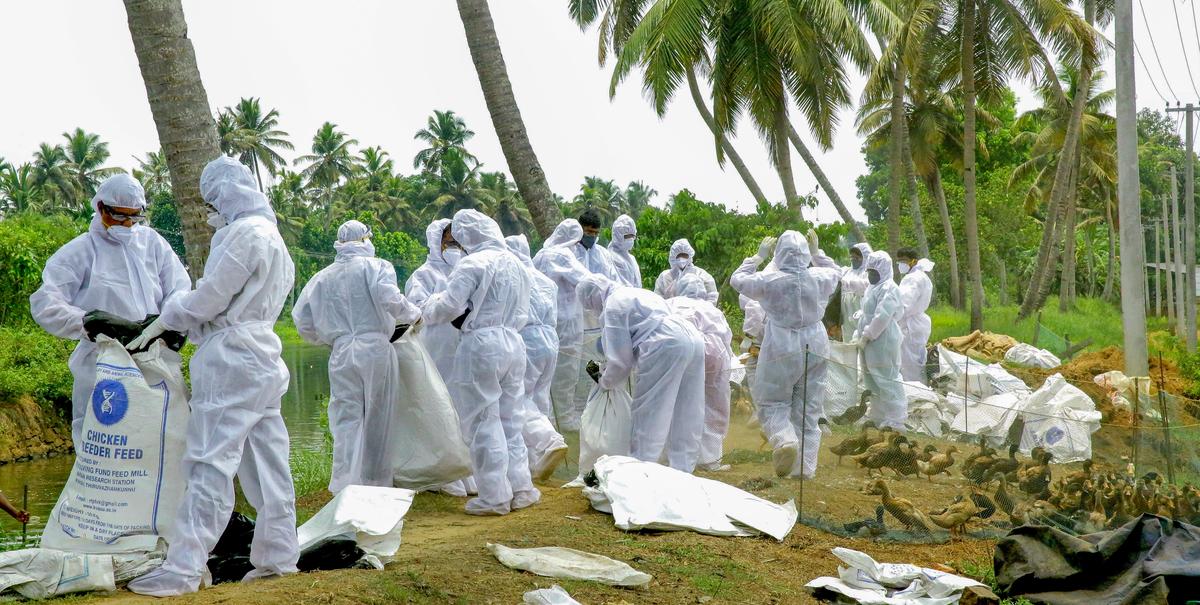The story so far: The highly pathogenic avian influenza (HPAI) H5N1 strain has been affecting cattle across several States in the U.S., and for the first time, three cases of human infection in dairy farm workers were also reported, raising fears of the risks of a wider transmission of this virus from cattle to humans. The districts of Alappuzha, Kottayam and Pathanamthitta in Kerala, where water bodies, migratory birds, fowls and integrated farms form part of the ecosystem, have reported H5N1 outbreaks in 19 places since April. However, the death of crows in large numbers in Alappuzha, and subsequent confirmation of the H5N1 virus in their carcasses have given rise to concerns that the virus could spread far and wide.
How dangerous is it?
Ever since it emerged in 1996, H5N1 has resulted in the mass killing of billions of wild birds as well as fowls. The virus’s jump to some 26 mammalian species, especially cattle and the now emerging proof that it can infect humans, has heightened the threat perception that H5N1 could lead to the next global pandemic. Of particular concern are the facts that herd-to-herd transmission of H5N1 is now taking place in the U.S., involving some 12 States and that the virus has been detected in raw milk and in milking machines.
According to scientists, the virus lacks changes that would make it better adapted to transmit between people and therefore, the risk to human health remains low. However, the potential for influenza viruses to rapidly evolve and the wide geographic spread of H5N1 signals that more human infections should be expected.
What is the level of risk to humans?
The virus seems to spread from birds/animals to humans who may be closely interacting with these, without adequate personal protection.
According to the WHO, between 2003 and April 1, 2024, close to 900 human infections of H5N1 have been reported from 23 countries, of which, more than half were fatal. Even though the risk of human infections from H5N1 is still perceived to be low, this can change rapidly as the virus spreads to more animals, especially cows or domestic mice, which have closer contact with humans. In districts like Alappuzha where water fowls, chicken, dairy cows and humans share the same environment, the opportunities for human infections should be perceived as high.
What are the symptoms of H5N1?
The common symptoms of H5N1 are similar to those of influenza-A illnesses, including respiratory difficulties, fever, cough, sore throat and pneumonia, all of which can potentially worsen, especially in those who are immunocompromised or have underlying conditions. In the U.S., conjuctivitis or pink eye was the only symptom that was reported in one of the farm workers who was infected.

In April itself, the Center for Disease Control and Prevention (CDC) had sent out a health advisory that clinicians should consider the possibility of H5N1 infection in persons who report with respiratory illness or conjunctivitis, if they have had exposure to livestock or dead birds. Early detection and containment of the infection is important to prevent the extensive spread of the virus.
As of now, in Kerala, as only the poultry has been found affected in all outbreaks, the strategy adopted for containment is the mass culling of birds within a certain radius of the reported infection. However, the incident of the mass death of crows has now changed the equation, as it is possible that the infection may have been taken by the crows beyond the current surveillance zone. Continuous surveillance by testing environmental samples — water, faecal matter of birds — as well as Influenza-like illness human samples would be necessary in designated surveillance zones. People who have livestock and birds at home are being advised to wear masks, and the antiviral Tamiflu is being prescribed as prophylaxis to people wherever H5N1 positive cases are found.
What are the necessary precautions?
People should avoid unprotected exposure to infected birds or animals or their contaminated environments. If at all one has been exposed to a possible H5N1-contaminated environment, they should monitor themselves for new respiratory illness symptoms, including conjunctivitis for 10 days and seek proper medical advice. It would be better to ensure that people use only pasteurised milk and poultry meat and eggs should be well-cooked to prevent any possible food-borne transmission of H5N1.

In a recent editorial, The Lancet, spoke about the need for a robust and coordinated response to H5N1. It pointed out that the concept of ‘One Health’, although often acknowledged, is rarely prioritised and operationalised.
Kerala, however, has taken ‘One Health’ beyond the conceptual framework and the project is currently being implemented as part of the World Bank-aided ‘Rebuild Kerala’ project in four districts — Alappuzha, Pathanamthitta, Kottayam, and Idukki. It has established a community-based disease surveillance network, with 2.5 lakh volunteers trained in the ‘One Health’ concept in these districts, who will report any unusual events or death of animals/birds in a locality so that early warning and early preventive or control measures can be taken.
month
Please support quality journalism.
Please support quality journalism.











